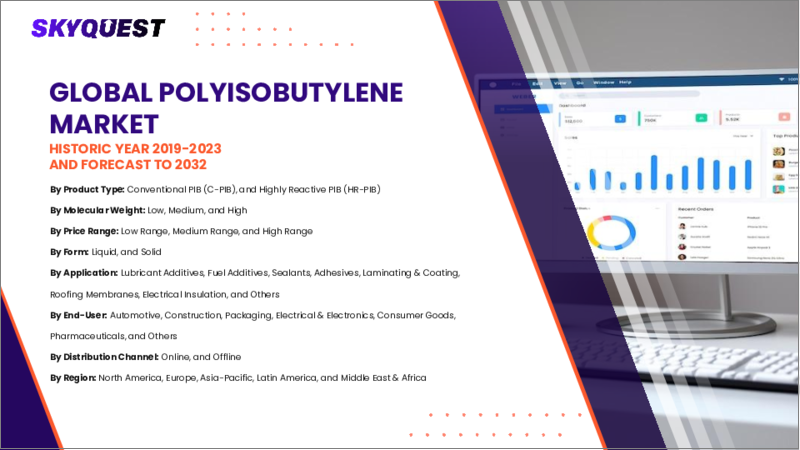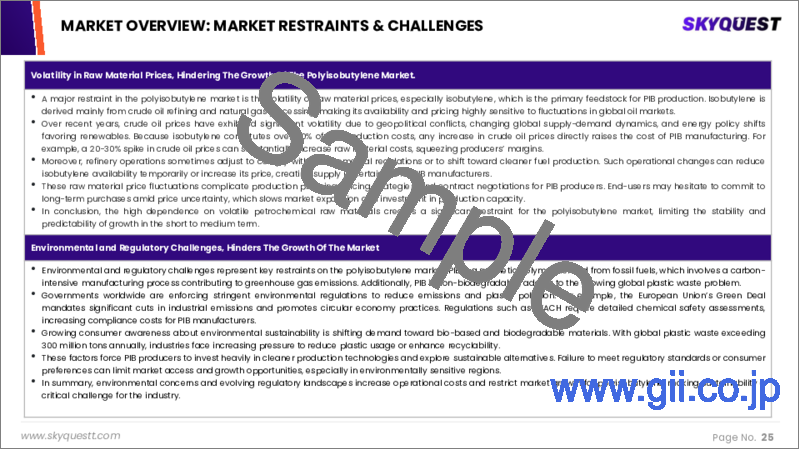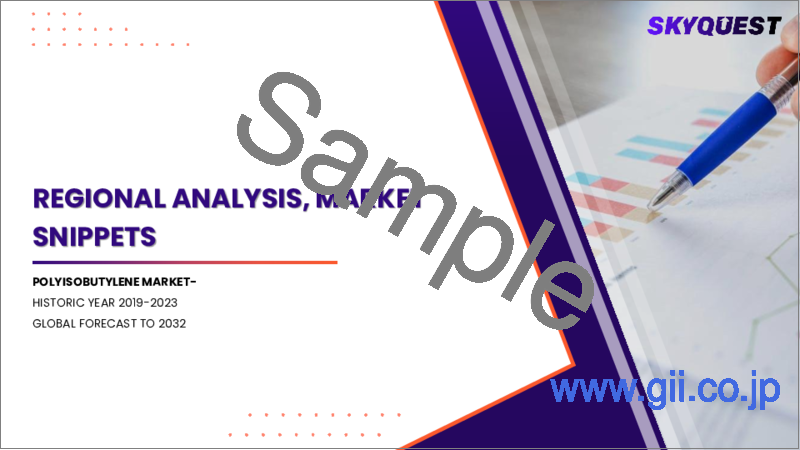|
|
市場調査レポート
商品コード
1663974
ポリイソブチレンの市場規模、シェア、成長分析:製品タイプ別、分子量別、用途別、最終用途産業別、地域別 - 産業予測 2025~2032年Polyisobutylene Market Size, Share, and Growth Analysis, By Product Type (C-PIB, HR-PIB), By Molecular Weight (Low, Medium), By Application, By End Use Industry, By Region - Industry Forecast 2025-2032 |
||||||
|
|||||||
| ポリイソブチレンの市場規模、シェア、成長分析:製品タイプ別、分子量別、用途別、最終用途産業別、地域別 - 産業予測 2025~2032年 |
|
出版日: 2025年02月22日
発行: SkyQuest
ページ情報: 英文 183 Pages
納期: 3~5営業日
|
全表示
- 概要
- 目次
ポリイソブチレン市場規模は2023年に25億米ドルと評価され、2024年の26億5,000万米ドルから2032年には41億9,000万米ドルに成長し、予測期間(2025-2032年)のCAGRは5.9%で成長する見通しです。
ポリイソブチレン(PIB)は、長鎖高分子構造、非刺激性、優れた接着性などのユニークな特性により、食品や医療用包装、特に医療用絆創膏の主要ポリマーとして台頭してきています。PIBを利用する主な産業は、建設、医薬品、農業、表面コーティングなど多岐にわたり、特にインドや中国などの新興市場において、自動車や建設分野で大きな成長が見込まれている。PIBは汎用性が高いため、接着剤、シーラント、自動車用ゴム部品、燃料・潤滑油添加剤などに応用できます。自動車産業におけるチューブレスタイヤの台頭は、酸素バリアとしてのPIBの役割を浮き彫りにし、メンテナンスの軽減と交換の容易さに貢献しています。また、気体透過性が低いため、絶縁性能も向上し、市場の可能性をさらに広げています。
目次
イントロダクション
- 調査の目的
- 調査範囲
- 定義
調査手法
- 情報調達
- 二次と一次データの方法
- 市場規模予測
- 市場の前提条件と制限
エグゼクティブサマリー
- 世界市場の見通し
- 供給と需要の動向分析
- セグメント別機会分析
市場力学と見通し
- 市場概要
- 市場規模
- 市場力学
- 促進要因と機会
- 抑制要因と課題
- ポーターの分析
主な市場の考察
- 重要成功要因
- 競合の程度
- 主な投資機会
- 市場エコシステム
- 市場の魅力指数(2024年)
- PESTEL分析
- マクロ経済指標
- バリューチェーン分析
- 価格分析
- 規制情勢
- ケーススタディ
ポリイソブチレン市場規模:製品タイプ別& CAGR(2025-2032)
- 市場概要
- C-PIB
- HR-PIB
ポリイソブチレン市場規模:分子量別& CAGR(2025-2032)
- 市場概要
- 低
- 中
- 高
ポリイソブチレン市場規模:用途別& CAGR(2025-2032)
- 市場概要
- 接着剤とシーラント
- 自動車用ゴム部品
- 燃料添加剤
- 潤滑剤添加剤
- その他
ポリイソブチレン市場規模:最終用途産業別& CAGR(2025-2032)
- 市場概要
- 交通機関
- 産業
- 食品
- その他
- 医薬品
- 建設
- 電気・電子
- 防護服
- 化粧品
- スポーツ用品
ポリイソブチレン市場規模:地域別& CAGR(2025-2032)
- 北米
- 米国
- カナダ
- 欧州
- ドイツ
- スペイン
- フランス
- 英国
- イタリア
- その他欧州地域
- アジア太平洋地域
- 中国
- インド
- 日本
- 韓国
- その他アジア太平洋地域
- ラテンアメリカ
- ブラジル
- その他ラテンアメリカ地域
- 中東・アフリカ
- GCC諸国
- 南アフリカ
- その他中東・アフリカ
競合情報
- 上位5社の比較
- 主要企業の市場ポジショニング(2024年)
- 主な市場企業が採用した戦略
- 最近の市場動向
- 企業の市場シェア分析(2024年)
- 主要企業の企業プロファイル
- 企業の詳細
- 製品ポートフォリオ分析
- 企業のセグメント別シェア分析
- 収益の前年比比較(2022-2024)
主要企業プロファイル
- BASF SE(Germany)
- Daelim Co., Ltd.(South Korea)
- Reliance Industries Ltd.(India)
- TPC Group(USA)
- The Lubrizol Corporation(USA)
- INEOS(UK)
- Nizhnekamskneftekhim(Russia)
- SIBUR(Russia)
- Kothari Petrochemicals Ltd.(India)
- Braskem(Brazil)
- Chevron Oronite Company LLC(USA)
- Jinzhou Jinex Lubricant Additives Co., Ltd.(China)
- YPF(Argentina)
- Shandong Hongrui New Material Technology Co., Ltd.(China)
- KEMAT(Belgium)
- JXTG Nippon Oil & Energy Corporation(Japan)
- Zhejiang Shunda New Material Co., Ltd.(China)
- Evonik Industries(Germany)
- Exxon Mobil Corporation(USA)
- Sinopec(China)
結論と提言
Polyisobutylene Market size was valued at USD 2.5 billion in 2023 and is poised to grow from USD 2.65 billion in 2024 to USD 4.19 billion by 2032, growing at a CAGR of 5.9% during the forecast period (2025-2032).
Polyisobutylene (PIB) is emerging as a key polymer in food and medical packaging, especially in medical plasters due to its unique attributes like a long chain macromolecular structure, non-irritating properties, and excellent adhesion. The major industries utilizing PIB span construction, pharmaceuticals, agriculture, and surface coatings, with significant growth projected in the automotive and construction sectors, particularly in emerging markets like India and China. PIB's versatility enables its application in adhesives, sealants, rubber automotive components, as well as fuel and lubricant additives. The rise of tubeless tires in the automotive industry highlights PIB's role as an oxygen barrier, contributing to reduced maintenance and easy replacement. Its low gas permeability also enhances its insulation capabilities, further expanding its market potential.
Top-down and bottom-up approaches were used to estimate and validate the size of the Polyisobutylene market and to estimate the size of various other dependent submarkets. The research methodology used to estimate the market size includes the following details: The key players in the market were identified through secondary research, and their market shares in the respective regions were determined through primary and secondary research. This entire procedure includes the study of the annual and financial reports of the top market players and extensive interviews for key insights from industry leaders such as CEOs, VPs, directors, and marketing executives. All percentage shares split, and breakdowns were determined using secondary sources and verified through Primary sources. All possible parameters that affect the markets covered in this research study have been accounted for, viewed in extensive detail, verified through primary research, and analyzed to get the final quantitative and qualitative data.
Polyisobutylene Market Segments Analysis
Global Polyisobutylene Market is segmented by Product Type, Molecular Weight, Application, End-Use Industry and region. Based on Product Type, the market is segmented into C-PIB and HR-PIB. Based on Molecular Weight, the market is segmented into Low, Medium and High. Based on Application, the market is segmented into Adhesives and Sealants, Automotive rubber components, Fuel additives, Lubricant additives and Others. Based on End-Use Industry, the market is segmented into Transportation, Industrial, Food, and Others. Based on region, the market is segmented into North America, Europe, Asia Pacific, Latin America and Middle East & Africa.
Driver of the Polyisobutylene Market
The Polyisobutylene market is primarily driven by the highly reactive segment, which holds a substantial market share due to its high viscosity and remarkable performance in lubricant thickening applications. This specific type of polyisobutylene exhibits increased reactivity, stemming from the terminal positioning of its double bonds, allowing it to undergo reactions swiftly. Consequently, this property facilitates the efficient and rapid production of various derivatives, making it a preferred choice for manufacturing dispersants and detergents. As a result, the demand in the market is consistently bolstered by the favorable characteristics and versatile applications of this reactive polymer.
Restraints in the Polyisobutylene Market
The polyisobutylene market faces significant restraints primarily due to the fluctuations in raw material prices, which can be influenced by various factors such as changes in oil prices, supply chain disruptions, and geopolitical tensions. These variances can lead to considerable price volatility, impacting manufacturers' operating costs and profitability. The reliance of polyisobutylene production on isobutylene, which is obtained from petrochemical feedstocks, exacerbates this issue, as any instability in the procurement of these materials can hinder production efficiency. Consequently, the uncertainty surrounding raw material costs poses a challenge to the overall dynamics of the polyisobutylene market.
Market Trends of the Polyisobutylene Market
The Polyisobutylene market is witnessing robust growth, particularly driven by the flourishing transportation industry in developing regions. As the automotive sector expands, the demand for high-performance tires and tubes-which utilize polyisobutylene due to its superior flexibility and customizable properties-continues to rise. This synthetic rubber's exceptional tensile strength makes it an ideal choice for automotive applications. Moreover, the increasing consumer demand for electronic devices, including smart TVs and wireless speakers, further fuels the market. Overall, the versatility and adaptability of polyisobutylene position it favorably, making it a key material in both automotive and consumer electronics industries.
Table of Contents
Introduction
- Objectives of the Study
- Scope of the Report
- Definitions
Research Methodology
- Information Procurement
- Secondary & Primary Data Methods
- Market Size Estimation
- Market Assumptions & Limitations
Executive Summary
- Global Market Outlook
- Supply & Demand Trend Analysis
- Segmental Opportunity Analysis
Market Dynamics & Outlook
- Market Overview
- Market Size
- Market Dynamics
- Drivers & Opportunities
- Restraints & Challenges
- Porters Analysis
- Competitive rivalry
- Threat of substitute
- Bargaining power of buyers
- Threat of new entrants
- Bargaining power of suppliers
Key Market Insights
- Key Success Factors
- Degree of Competition
- Top Investment Pockets
- Market Ecosystem
- Market Attractiveness Index, 2024
- PESTEL Analysis
- Macro-Economic Indicators
- Value Chain Analysis
- Pricing Analysis
- Regulatory Landscape
- Case Studies
Global Polyisobutylene Market Size by Product Type & CAGR (2025-2032)
- Market Overview
- C-PIB
- HR-PIB
Global Polyisobutylene Market Size by Molecular Weight & CAGR (2025-2032)
- Market Overview
- Low
- Medium
- High
Global Polyisobutylene Market Size by Application & CAGR (2025-2032)
- Market Overview
- Adhesives and Sealants
- Automotive rubber components
- Fuel additives
- Lubricant additives
- Others
Global Polyisobutylene Market Size by End-Use Industry & CAGR (2025-2032)
- Market Overview
- Transportation
- Industrial
- Food
- Others
- Pharmaceuticals
- Construction
- Electrical & Electronics
- Protective Clothing
- Cosmetics
- Sporting Goods
Global Polyisobutylene Market Size & CAGR (2025-2032)
- North America (Product Type, Molecular Weight, Application, End-Use Industry)
- US
- Canada
- Europe (Product Type, Molecular Weight, Application, End-Use Industry)
- Germany
- Spain
- France
- UK
- Italy
- Rest of Europe
- Asia Pacific (Product Type, Molecular Weight, Application, End-Use Industry)
- China
- India
- Japan
- South Korea
- Rest of Asia-Pacific
- Latin America (Product Type, Molecular Weight, Application, End-Use Industry)
- Brazil
- Rest of Latin America
- Middle East & Africa (Product Type, Molecular Weight, Application, End-Use Industry)
- GCC Countries
- South Africa
- Rest of Middle East & Africa
Competitive Intelligence
- Top 5 Player Comparison
- Market Positioning of Key Players, 2024
- Strategies Adopted by Key Market Players
- Recent Developments in the Market
- Company Market Share Analysis, 2024
- Company Profiles of All Key Players
- Company Details
- Product Portfolio Analysis
- Company's Segmental Share Analysis
- Revenue Y-O-Y Comparison (2022-2024)
Key Company Profiles
- BASF SE (Germany)
- Company Overview
- Business Segment Overview
- Financial Updates
- Key Developments
- Daelim Co., Ltd. (South Korea)
- Company Overview
- Business Segment Overview
- Financial Updates
- Key Developments
- Reliance Industries Ltd. (India)
- Company Overview
- Business Segment Overview
- Financial Updates
- Key Developments
- TPC Group (USA)
- Company Overview
- Business Segment Overview
- Financial Updates
- Key Developments
- The Lubrizol Corporation (USA)
- Company Overview
- Business Segment Overview
- Financial Updates
- Key Developments
- INEOS (UK)
- Company Overview
- Business Segment Overview
- Financial Updates
- Key Developments
- Nizhnekamskneftekhim (Russia)
- Company Overview
- Business Segment Overview
- Financial Updates
- Key Developments
- SIBUR (Russia)
- Company Overview
- Business Segment Overview
- Financial Updates
- Key Developments
- Kothari Petrochemicals Ltd. (India)
- Company Overview
- Business Segment Overview
- Financial Updates
- Key Developments
- Braskem (Brazil)
- Company Overview
- Business Segment Overview
- Financial Updates
- Key Developments
- Chevron Oronite Company LLC (USA)
- Company Overview
- Business Segment Overview
- Financial Updates
- Key Developments
- Jinzhou Jinex Lubricant Additives Co., Ltd. (China)
- Company Overview
- Business Segment Overview
- Financial Updates
- Key Developments
- YPF (Argentina)
- Company Overview
- Business Segment Overview
- Financial Updates
- Key Developments
- Shandong Hongrui New Material Technology Co., Ltd. (China)
- Company Overview
- Business Segment Overview
- Financial Updates
- Key Developments
- KEMAT (Belgium)
- Company Overview
- Business Segment Overview
- Financial Updates
- Key Developments
- JXTG Nippon Oil & Energy Corporation (Japan)
- Company Overview
- Business Segment Overview
- Financial Updates
- Key Developments
- Zhejiang Shunda New Material Co., Ltd. (China)
- Company Overview
- Business Segment Overview
- Financial Updates
- Key Developments
- Evonik Industries (Germany)
- Company Overview
- Business Segment Overview
- Financial Updates
- Key Developments
- Exxon Mobil Corporation (USA)
- Company Overview
- Business Segment Overview
- Financial Updates
- Key Developments
- Sinopec (China)
- Company Overview
- Business Segment Overview
- Financial Updates
- Key Developments





